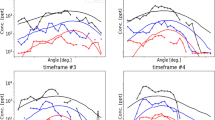Abstract
The quality of the simulation of the motion and spread of a passive substance in a puff model depends on the ability to estimate the speed of the wind at the source height and standard deviation of concentration both in time and space. The wind profile is calculated using the standard Monin-Obukhov similarity theory and standard deviation of concentration, (“sigmas” in the further text) is calculated using a scheme based on the second-order closure theory. To asses the success of the model comparison was made with two other approaches for the calculation of the “sigmas”, the Briggs empirical method and a semi-empirical scheme based on the statistical theory. All of these methods are based on the various parameters of turbulence which were calculated from standard measurements using the so called meteorological pre-processing. Finally the results were compared with the results from the measurements from Tracer Dispersion Experiments in the Copenhagen Area during 1978/1979. First we have analyzed the wind extrapolation results and when we were satisfied with those we did comparisons with the observed concentration.
Access this chapter
Tax calculation will be finalised at checkout
Purchases are for personal use only
Similar content being viewed by others
References
Briggs GA (1973) Diffusion estimates for small emissions. NOAA, ERL Report. ATDL-79, 59 pp
Carruthers DJ, Weng WS, Hunt JCR, Holroyd RJ, McHugh CA, Dyster SJ (2003) Atmopheric dispersion modelling system (UK-ADMS). Plume/puff spread and mean concentration module specifications document UK ADMS 1.0; P10/01 T/03; P12/01 T/03 12.03. from UK-ADMS 1.3 technical specification
Lewellen WS (1977) Use of invariant modeling. In: Frost W, Moulden TH (eds) Handbook of turbulence. Plenum Press, New York, pp 237–280
Rajkovic B, Arsenic I, Grsic Z (2008) Point source atmospheric diffusion. In: Gualtieri C, Mihailovic DT (eds) Fluid mechanics of environmental interfaces. Taylor and Francis, London, pp 1–17
Sykes RI, Gabruk RS (1997) A second-order closure model for the effect of averaging time on turbulent plume dispersion. J Appl Meteorol 36:165–184
Sykes RI, Lewellen WS, Parker SF (1986) A Gaussian plume model of atmospheric dispersion based on second-order closure. J Clim Appl Meteorol 25:322–331
Sykes RI, Parker SF, Henn DS, Cerasoli CP, Santos LP (2000) PC-SCIPUFF Version 1.3 technical documentation. A.R.A.P Report No. 725. Titan Corporation, ARAP Group
Van Ulden AP, Holtslag AAM (1985) Estimation of atmospheric boundary layer parameters for diffusion applications. J Clim Appl Meteorol 24:1196–1207
Acknowledgments
This work has been partially funded by the Republic of Serbia, Ministry of Science, grants no. 1197 and 141035, Italian ministry of Environment and territories through its two projects, SINTA and ADRICOSM-STAR
Author information
Authors and Affiliations
Corresponding author
Editor information
Editors and Affiliations
Rights and permissions
Copyright information
© 2011 Springer Science+Business Media B.V.
About this paper
Cite this paper
Podrascanin, Z.M., Rajkovic, B. (2011). Calculation of Standard Deviation of Concentration Using a Second-Order Closure Theory. In: Steyn, D., Trini Castelli, S. (eds) Air Pollution Modeling and its Application XXI. NATO Science for Peace and Security Series C: Environmental Security. Springer, Dordrecht. https://doi.org/10.1007/978-94-007-1359-8_25
Download citation
DOI: https://doi.org/10.1007/978-94-007-1359-8_25
Published:
Publisher Name: Springer, Dordrecht
Print ISBN: 978-94-007-1358-1
Online ISBN: 978-94-007-1359-8
eBook Packages: Earth and Environmental ScienceEarth and Environmental Science (R0)




